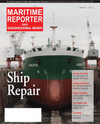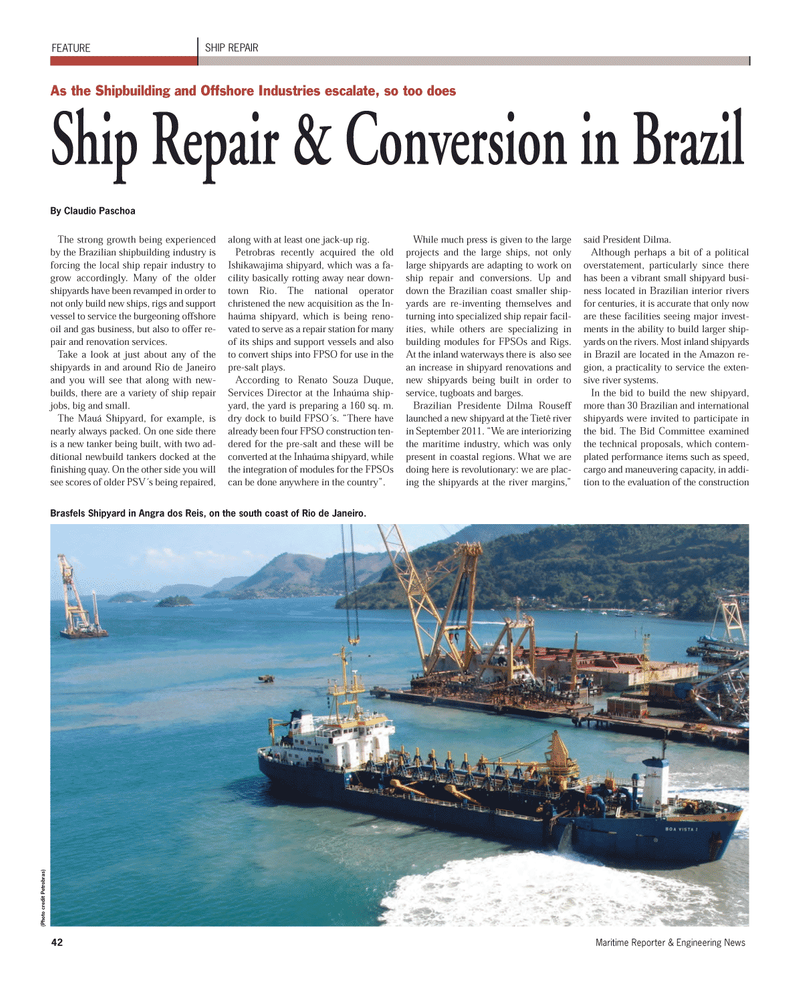
Page 42: of Maritime Reporter Magazine (March 2012)
The Ship Repair Edition
Read this page in Pdf, Flash or Html5 edition of March 2012 Maritime Reporter Magazine
42Maritime Reporter & Engineering News The strong growth being experienced by the Brazilian shipbuilding industry is forcing the local ship repair industry togrow accordingly. Many of the older shipyards have been revamped in order to not only build new ships, rigs and support vessel to service the burgeoning offshore oil and gas business, but also to offer re- pair and renovation services. Take a look at just about any of the shipyards in and around Rio de Janeiro and you will see that along with new- builds, there are a variety of ship repair jobs, big and small.The Mauá Shipyard, for example, is nearly always packed. On one side there is a new tanker being built, with two ad- ditional newbuild tankers docked at the finishing quay. On the other side you will see scores of older PSV´s being repaired,along with at least one jack-up rig.Petrobras recently acquired the oldIshikawajima shipyard, which was a fa- cility basically rotting away near down- town Rio. The national operator christened the new acquisition as the In- haúma shipyard, which is being reno- vated to serve as a repair station for many of its ships and support vessels and also to convert ships into FPSO for use in the pre-salt plays. According to Renato Souza Duque,Services Director at the Inhaúma ship-yard, the yard is preparing a 160 sq. m.dry dock to build FPSO´s. ?There have already been four FPSO construction ten-dered for the pre-salt and these will beconverted at the Inhaúma shipyard, while the integration of modules for the FPSOs can be done anywhere in the country?. While much press is given to the large projects and the large ships, not only large shipyards are adapting to work on ship repair and conversions. Up and down the Brazilian coast smaller ship- yards are re-inventing themselves and turning into specialized ship repair facil- ities, while others are specializing inbuilding modules for FPSOs and Rigs. At the inland waterways there is also see an increase in shipyard renovations and new shipyards being built in order to service, tugboats and barges. Brazilian Presidente Dilma Rouseff launched a new shipyard at the Tietê river in September 2011. ?We are interiorizing the maritime industry, which was only present in coastal regions. What we are doing here is revolutionary: we are plac- ing the shipyards at the river margins,? said President Dilma. Although perhaps a bit of a politicaloverstatement, particularly since there has been a vibrant small shipyard busi- ness located in Brazilian interior rivers for centuries, it is accurate that only now are these facilities seeing major invest- ments in the ability to build larger ship- yards on the rivers. Most inland shipyards in Brazil are located in the Amazon re- gion, a practicality to service the exten- sive river systems. In the bid to build the new shipyard, more than 30 Brazilian and internationalshipyards were invited to participate in the bid. The Bid Committee examined the technical proposals, which contem-plated performance items such as speed,cargo and maneuvering capacity, in addi- tion to the evaluation of the construction FEATURE SHIP REPAIR As the Shipbuilding and Offshore Industries escalate, so too does Ship Repair & Conversion in Brazil Brasfels Shipyard in Angra dos Reis, on the south coast of Rio de Janeiro. By Claudio Paschoa(Photo credit Petrobras) MR March 12 # 6 (41-49):MR Template 3/6/2012 12:37 PM Page 42

 41
41

 43
43
